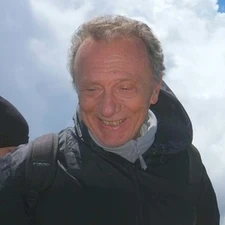Carlo Laj

The 2015 Arthur Holmes Medal & Honorary Membership is awarded to Carlo Laj for seminal contributions in tectonics, marine stratigraphy (palaeoceanography) and geomagnetism (palaeomagnetism).
The work of Carlo Laj transformed the field of tectonics, marine stratigraphy (palaeoceanography) and geomagnetism (palaeomagnetism), and in so doing motivated a wide range of investigations that are at the forefront of geoscience today. Moving from solid-state physics, Laj saw the potential of the still nascent application of palaeomagnetism to tectonics. His early work provided the framework for subduction rollback in the Mediterranean, and it continues to be a fundamental resource. Laj recognised that advances in magnetometer development (which he motivated with the late William Goree) could provide a step function in the resolving power of geological records of the geomagnetic field and, in particular, of past field strength (palaeointensity), excursions and reversals. These advances motivated many seagoing expeditions, and are at the heart of a new millennial scale palaeointensity stratigraphy that holds tremendous potential to help unravel palaeoclimate history. Laj was also quick to recognise that advances in accelerator mass spectrometry allowing greater increased sensitivity for cosmogenic radionuclides (10Be, 36Cl) offered the potential to resolve questions about the nature of geomagnetic excursions and reversals. Today, these data have become indispensible tools for determining the existence and global (versus local) nature of excursions, requisite constraints for understanding associated core processes. He also recognised that 14C measurements could be combined with the ever-increasing age-fidelity of marine sediments to learn more about oceanic circulation and climate change.
One of Laj’s boldest and most influential ideas was illustrated on a now-famous cover of Nature: he showed that geomagnetic reversal transition paths coincide with seismically cold regions underlying the continents. Hence, there appears to be a lower-mantle control on the reversing geodynamo. This simple picture has had a far-reaching impact, with the idea immediately being included in textbooks on palaeomagnetism. It motivated innumerable efforts to test the data (seismic and palaeomagnetic) using ever-improving technologies and site distributions. It instantly brought together communities working in isolation. This was not just a matter of bringing sub-disciplines of geology and geophysics together. It motivated theorists and experimentalists to talk in meaningful new ways, a dialogue that continues today in the various groups that represent studies of the Earth’s deep interior.
Laj has held a series of academic leadership roles, and has mentored many young scientists who are now leaders in their fields. He has organised topical scientific conferences that further influenced the community (e.g. the London discussion meeting on geomagnetic polarity reversals). Laj has also had a profound impact on shaping the next generation of geoscientists by founding successful education programmes. In combining hugely influential advances in geosciences with ground-breaking promotion of geoscience education, Carlo Laj stands alone.
